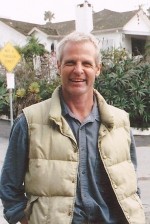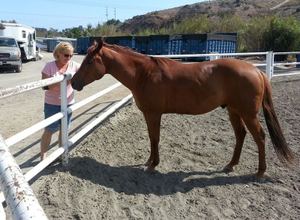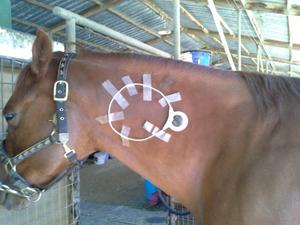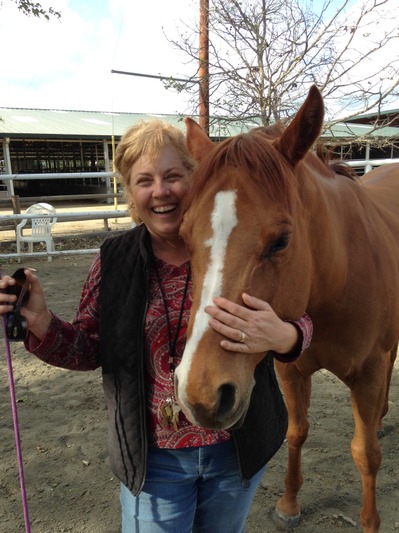Gunner, a 7-year-old Quarter Horse in California, exhibited occasional lameness for years. After it was finally diagnosed as a neurological deficit, owner Darlene Dorff (along with veterinarian Mark Secor) used the Assisi Loop to treat him. This is their story!

A word from Dr. Mark Secor of Mission Equine, as of March 2015:
Dr. Secor says of Gunner, “There really has been an improvement; [50% improvement overall] would be a good way to put it. He really wasn’t rideable before, and she’s able to now.”
“Before [the Assisi Loop], it was very difficult for [Gunner] to stay in the correct lead,” he says. “He would almost always swap leads in both directions. Now, he occasionally swaps leads, but it’s not a big deal for him. It looks like a normal canter.”
Both Darlene and Dr. Secor mention Gunner’s mood. “The other thing you can tell in this horse is he’s much happier,” Dr. Secor says. “He was pretty darn crabby when she started the process. His attitude has improved significantly.”
Dr. Secor describes visible muscle growth in the neck area where the Loop was used, and “a lot of the neurological things we look for were improved significantly. We do a placement test, where we set their front legs out to the side and they should normally put them back under the horse’s body. We also move them across the body and they should move it from medial position back to under their body, and his were noticeably better than they were in October [2014].”
Gunner’s panniculus response was noticeably better on both sides of his neck. He had a “noticeable improvement” in pivoting, and, while he is still weak on a tail pull, he has improved greatly since October.
In closing, Dr. Secor says that “[adding the Assisi Loop] is the only thing we changed.”
 Darlene Dorff, the owner of a 7-year-old Quarter Horse named Gunner, noticed that her horse would be lame some days and fine others – and it got to the point that he was no longer rideable. She called her vet out for a lameness exam, but it soon became clear that the problem was neurological.
Darlene Dorff, the owner of a 7-year-old Quarter Horse named Gunner, noticed that her horse would be lame some days and fine others – and it got to the point that he was no longer rideable. She called her vet out for a lameness exam, but it soon became clear that the problem was neurological.
When Dr. Mark Secor did an on-site x-ray of Gunner’s neck, he saw that there was compression at vertebrae C4 and C5, which is a classic sign of Wobblers Syndrome. The only way to truly diagnose Wobblers would be a myelogram, which is very expensive and invasive, so Darlene opted to instead treat Gunner for the suspected Wobblers with stretches, nutritional modification, and Acuscope.
Acuscope treatments are done with a large machine that can be cumbersome to set up, and due to scheduling difficulty, Darlene was only able to get Gunner a couple of treatments per week. “He seemed to feel better,” Darlene says of the Acuscope treatments, “but we couldn’t get enough treatments to see a substantial difference.” In searching for a more user-friendly and portable option, she came across the Assisi Loop.
 In October 2014, Darlene received her first Assisi Loop and immediately started treatment. She started out giving Gunner four to six Loop treatments per day for the first four weeks.
In October 2014, Darlene received her first Assisi Loop and immediately started treatment. She started out giving Gunner four to six Loop treatments per day for the first four weeks.
“After three days with the Loop, he loped. It was amazing. Did he crossfire a little bit? Yes, but he couldn’t even get into a lope before. That’s when my heart began to think, wow, this could be possible.”
As she continued treatment, Gunner only improved. “He can trot with ease when I’m on his back, and the other day for the first time in about two years he loped with me on his back. … He couldn’t run before this. His back feet wouldn’t do what he wanted them to do. But he was running like the wind the other day with his tail straight up… It was the most beautiful thing to me. He’s getting to be a horse again.”
In addition to his movement, Gunner’s temperament has shifted. Before Darlene began using the Loop, Dr. Secor and Darlene agreed that Gunner was very frustrated. He couldn’t get his legs to go where he wanted them to go.
“His eyes are softer,” she says. “Before, he looked angry. He looked angry and frustrated, and we interpreted that as pain. The last time I tried to lope him before we knew about Wobblers, he bucked me off. He hasn’t bucked with me on his back, or even tried to buck with me on his back, at all. … His confidence is coming back.”
Darlene now only treats Gunner a few times a week, or when he seems to be getting a little unsteady on his back feet.
“I can’t say enough good things. I’m thrilled. I have my horse back.”

